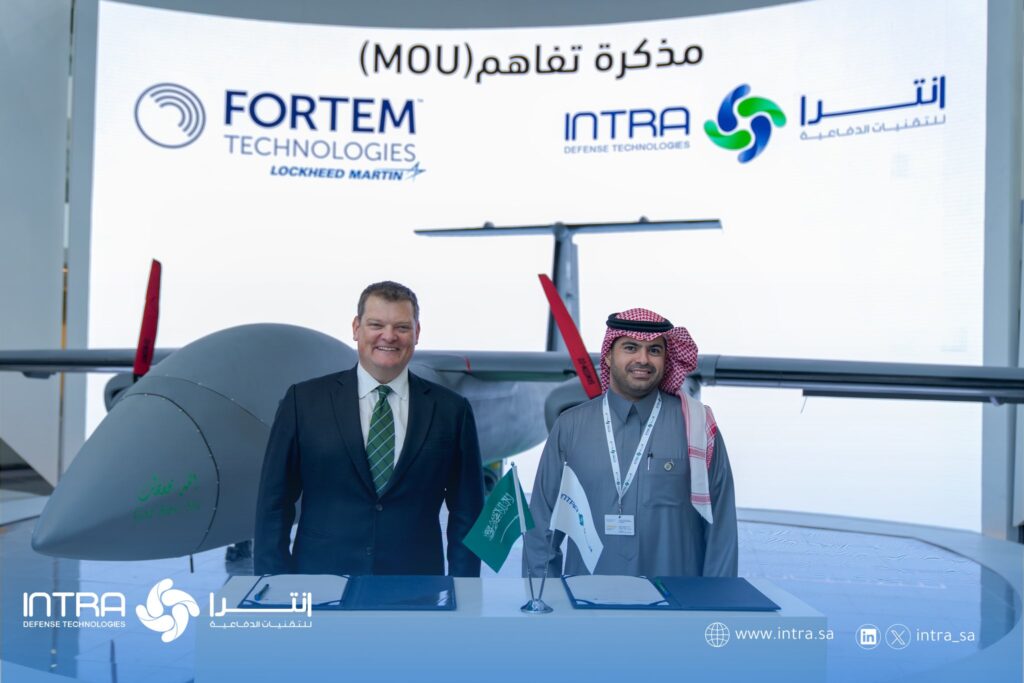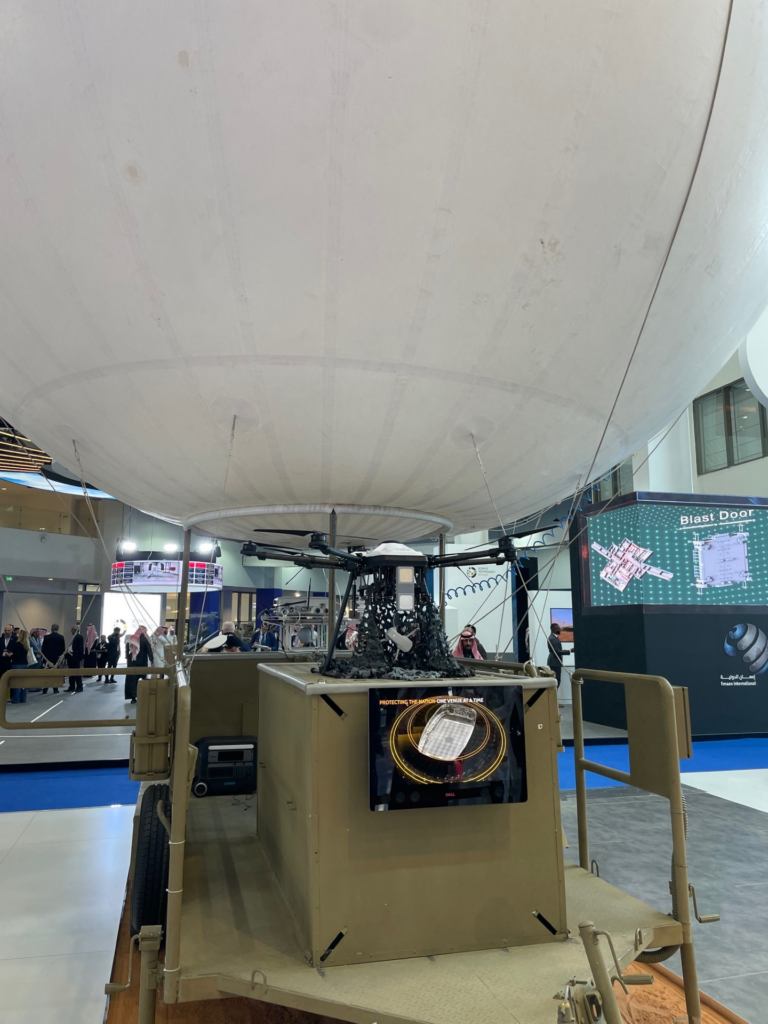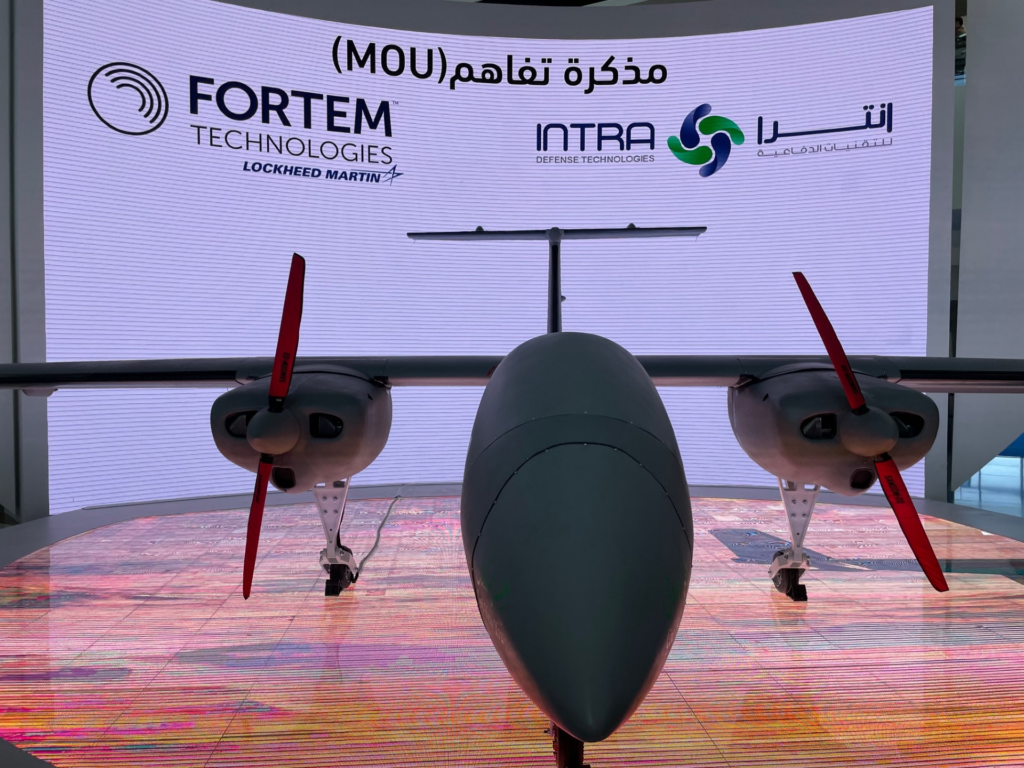Interview: Fortem’s Partnership To Hunt Drones In Saudi Arabia
Counter-drone defense system developer Fortem Technologies announced a strategic partnership with Saudi Arabian drone manufacturer INTRA Defense Technologies to jointly market and develop counter-drone systems for the Saudi Arabian market at the 2024 World Defense Show in Riyadh.
Overt Defense had the opportunity to speak with Fortem chief executive officer Jon Gruen on the partnership, and how the collaboration between the companies will unfold.
To start things off, how did Fortem Technologies and INTRA meet?
It’s actually a great story from our point of view in that we received investment from Lockheed Martin last year, and we worked a number of different efforts with them, both technically as well as in the development world. One of the most fruitful relationships we’ve had is with Lockheed Martin Saudi Arabia, and they introduced us to INTRA about six months ago.
We went over, toured their facility and met their leadership team. The relationship moved very quickly from there because we had so many synergistic capabilities, moving all the way through signing the Strategic Alliance Agreement at the World Defense Show. So the short answer is Lockheed Martin made the introduction and kind of shepherded the relationship. And due to the nature of the two companies it made a lot of sense that we moved quickly on it.

Was there a specific moment where the two companies decided that they had the right match for a partnership?
Yes, I think it was in November when I went and toured their facility in Saudi Arabia, and saw that they were building drones all the way up to what here in the States we call Group 4. Fixed wing, long duration surveillance and reconnaissance drones, kind of similar in size and scope to what our Predators, Reapers and Global Hawks do in the Department of Defense stockpiles.
When you see that capability of engineering and manufacturing and just their footprints, they’ve been in business for almost 10 years now, producing drones at that size and scale. It was immediately apparent to me that they had the capabilities to produce and even design the future platforms that our technology would be core pieces of.
That leads into my next question – what does INTRA bring to Fortem’s existing technologies?
We’re really exploring a new model where if you look at Saudi Arabia, they have a mandate under Vision 2030 to have somewhere between 50 and 60% localization by 2030, which means that if the Saudi Ministry of Defense buys a defense article, it is mandated to have 50 to 60% local content, period.
They’re not going to buy international products wholesale anymore. They’re going to mandate this partnership with local businesses to provide that local content. So understanding that, I have looked at a model where Fortem has key technologies in our radar and in our software and in some cases in our effectors. So whether that’s a net based capture system or others, all of that are subsystems to a complete drone system that is used to go and hunt other drones.
The long term capabilities that INTRA brings is the ability to design new drones that are purpose built to their environment, and then manufacture them in Saudi Arabia as well.
Is there a roadmap for how this partnership is going to develop?
We have a 2030 time frame we’re working towards. What that allows is for INTRA to initially facilitate the sale of our current product lines in Saudi Arabia with key customers. And then as we do those initial deployments, in parallel, we’re going to take the lessons learned and look at what the next generation of our counter-UAS system would need to look like.
And then that next generation will be co-developed and manufactured with INTRA in the country. So again, it’s kind of initially building our current product line and then the next generation will be a co-developed product line.
Do you see this partnership as an opportunity to better place your product in the regional market?
Yes. I think it’s going to be heavily focused on internal Saudi Arabia customers initially. And again, the scale that that can be reached between customers like the Saudi National Guard or Aramco is plenty big for the near term. And then as we proof out the systems inside Saudi Arabia and create tailored products that really work in those high stress environments, that certainly will be looked at when moving into a regional model a little bit down the road.
Will localization pose any issues with ITAR regulations?
It depends on who you are. We have ITAR releasable versions of every product we make, so we don’t have an issue. And then with regards to the joint development going forward, again, we’re bringing our capabilities, our knowledge, each of us bringing what we know best.
So we’re going to bring radars and software that was developed in the States, but is exportable. We will bring that and be able to iterate on that in a compliant way. And then INTRA is going to build the drones, which they do anyway, and that’s all internal to them. So, no, I don’t see any issues long term with ITAR.
The beauty of the joint development program is that all of the intellectual property that’s developed in that joint program will remain with INTRA in Saudi Arabia. When we talk about localization, it’s more than just jobs, it’s developing intellectual property. And because we’re coming from an ITAR-free base on our technology that we will be working with them on, what is developed remains ITAR-free and then the IP gained is held on the INTRA side.
Does INTRA partially or fully own the IP resulting from joint development?
Our core pieces that are our IP will always remain our IP, in the radars and a number of software modules. But the other IP that’s generated from the new drones that are built, all the control software and everything, we integrate our subsystems in there and make it work. But all of that new IP on how to build a drone that hunts other drones, will remain on their side.
Is this a purely technological partnership or is there a financial side to things, like is INTRA investing in Fortem as well?
Not at this time. We certainly have had discussions on that possibility, but right now it’s just purely a business relationship.
Speaking of business, how have the various Houthi drone attacks in the region affected demand or interest in Fortem products?
It spiked interest, 100%. As you mentioned, there are real world threats happening every day in the region. And we’re leveraging our experience from Ukraine and other locations which see the same type of threats. So the Shaheds and other Iranian developed drones, kamikaze drones, they have proliferated to a number of different locations around the globe. And so, you know, we’re taking lessons learned from everywhere to develop the best counter-UAS systems that we can.

Are there any such lessons since the last time we spoke that you can share?
Well, the Shaheds are changing, they are being advanced, developed, just like we’re developing our counter systems as fast as we can. The Shaheds are made of new materials now. They’re faster. They operate in GPS-denied environments more effectively. So they’re maturing their technology and that’s going everywhere, down to Yemen or to Russia or other places. The cat and mouse game of who can develop faster, that’s a real thing.
There was a data leak suggesting that the Russians are targeting a price around $50,000 US dollars per drone for their license produced Shahed drones. Do you see this as a vindication of the DroneHunter model of having a non-consumable drone intercepting them?
Yes, and that’s why I say that the next generation of Shahed might be a family of systems. We’re now building layered defense systems, layered counter-drone systems with multiple types of effectors, whether that’s multiple types of drone responses, net-based, explosive-based, high-power microwave, a number of different capabilities that are either deployed or in the works.
What we are probably moving towards are swarm-on-swarm engagements. We’re not there yet on either side, offensive or defensive, but we’re out on the bleeding edge of developing those capabilities with a number of effectors in a layered model with full autonomy, so that you don’t have men trying to fly drones to catch other drones as that doesn’t work. We’re very rapidly moving to much more mature, much more layered, much more all-encompassing counter-UAS systems.
You have mentioned the increased interest, but are any of the clients more hesitant to be seen dealing with an American company due to Israel’s war with Hamas?
I have experienced that, and that’s part of the reason that we partner with someone like INTRA because they have the local credibility. So we’re really assisting them in fielding an organic, Saudi counter-UAS system.
This is probably crossing over into something I should be asking them, but do they have any plans they’ve shared with you so far on how soon they want to get something jointly developed using your technology out?
Yeah, we’re off and running now. We’re doing demonstrations of our current product lines to customers in the Kingdom, and that’s our initial fielding capability. And then we’ve created the partnership agreement to start doing joint development once we start seeing where the technology needs to be adapted and what needs to be developed for future systems. So, we’re off and running basically on both fronts.
You’ve mentioned that the Saudi National Guard is one of the main clients for the collaboration. Does the partnership purely focus on government clients, or are companies and other non-government organizations still very much within the target market?
Aramco depends on what you classify them as, but technically they’re a company. They just have massive infrastructure, and sometimes it’s seen as almost a government organization. But any critical infrastructure, whether it’s gas and oil, national borders, stadiums, energy plants through houses, it’s available to all.
What’s the current mood of the partnership?
The World Defense Show was a great kickoff for us. We were prominent in INTRA’s booth, and they had more traffic through their booth than any other company at the show including Saudi Arabian Military Industries and the General Authority for Military Industry, which is a testament to the product lines that they had displayed and their prominence in the aerospace and defense industry there. We came off World Defense Show on very big emotional highs, meeting a lot of customers and setting up a whole calendar full of engagements coming up. So we are very excited about our partnership and how quickly it’s going to mature in the Kingdom.
Any closing thoughts?
I probably mentioned it to you before, we’re talking about the counter UAS space right now, and this is applicable globally, but particularly in places like Saudi Arabia and even Southeast Asia, we’re quickly moving towards advanced air mobility in those regions.
They’re very proactive, they’re very forward thinking. So, using drones to do middle mile logistics, passenger drones in cities, all of that requires a new technical infrastructure that has to be fielded, and we have core technologies there with our radars and software. These partnerships are going to grow into more than just the counter-UAS defense space, and it’s actually going to mature very quickly, I believe.

